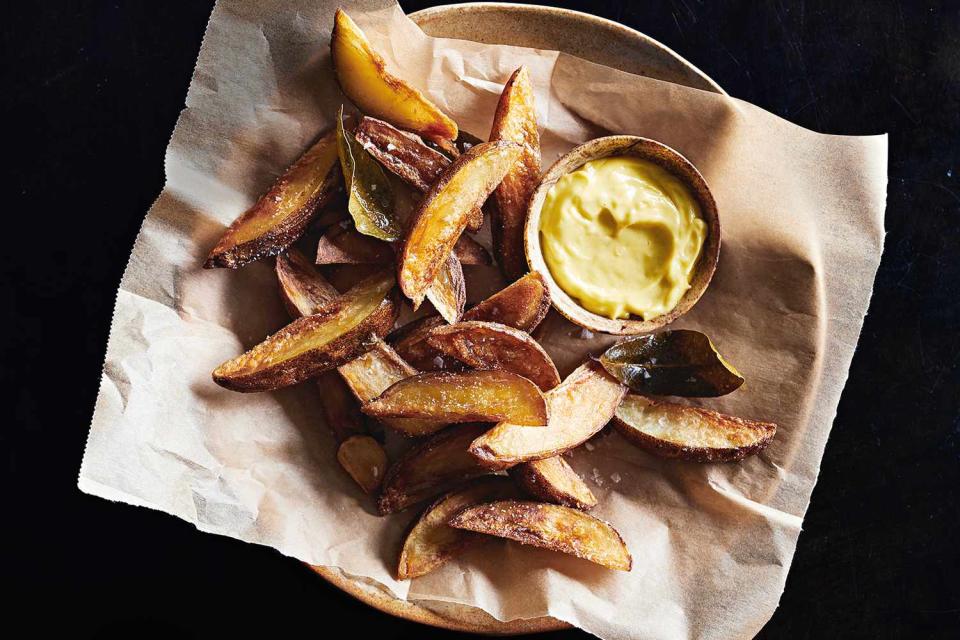What Is Aioli? Here's How to Make This Delicious, Garlicky Sauce at Home
TABLE OF CONTENTS
On This Page
What Is Aioli?
Aioli vs. Mayo
How to Make
How to Use
Storage
For an easy, all-purpose sauce that only sounds fancy, look no further than the powerhouse that is aioli. The sauce, claimed by both French and Spanish cuisines, is similar to mayonnaise, but there are subtle, but surefire differences. Here, learn more about aioli sauce, including its ingredients, how it is made, and how it can best be used in recipes.
Related: 5 Famed French Sauces Every Home Cook Should Know
What Is Aioli Sauce?
Traditionally a pungent two-ingredient sauce made with garlic and olive oil, aioli also has a two-part name: ail is French for garlic and oli is Provençal for oil. Aioli is used around the northern Mediterranean, particularly in Eastern Spain and in Southern France (mainly Provence). Like many foods from those areas, its fame has spread.
In the restaurant world, particularly since around 1990, aioli has seen been in the spotlight, although frequently what is labeled aioli is misrepresented. "Sometimes the culinary terms mayo and aioli are used interchangeably," says Olivia Roszkowski, chef-instructor of plant-based culinary arts at the Institute of Culinary Education. "Probably because aioli has a nice sound to it when showcased on menus."

Johnny Miller
Aioli vs. Mayo
Despite their similarities, there is a clear difference between aioli and mayonnaise: Mayo is made by emulsifying egg yolks and oil—generally, a neutral oil. In its most traditional form, aioli is simply fresh garlic emulsified with olive oil. But the aioli we know and love includes egg yolks for extra richness, and today, this version seems to dominate, which adds to the confusion.
Making Aioli at Home
Traditional aioli calls for a mortal and pestle, but most home kitchens today are equipped with a tool that makes the job much easier—the food processor. "The general technique is to emulsify the oil into the egg to make it into a thick suspension," says Roszkowski.
Ingredients
Be thoughtful about the quality of ingredients you use for such a simple and straightforward sauce, especially as they will all be raw, says Roszkowski.
Oil: "Select the freshest oil you can find, as oils tend to go rancid when exposed to heat, air, or light, and that can compromise the flavor of your aioli," Roszkowski says. We often use olive oil for aioli, but Roszkowski prefers using a neutral, refined polyunsaturated oil such as canola, grapeseed, or sunflower oil, "so the texture remains constant when refrigerated and the oil flavor is not too pronounced."
Eggs: Buy fresh, free-range eggs; these will provide the best quality yolks for the aioli.
Garlic: Use fresh, young garlic for aioli (or whenever you're eating it raw), because older garlic will also lend a stronger flavor. "I recommend finely mincing, crushing, or making your garlic into a paste before introducing it to the mixture for uniformity in texture," says Roszkowski. (She notes that finely chopping the garlic will make the garlic flavor stronger, as it crushes the cell walls of the clove.)
Mustard: Though not traditional, mustard is often added to aioli to aid in the binding process. A mustard like Dijon also provides a nice flavor. The addition of an acid like lemon juice or vinegar can also round out the flavor.
How to Make Aioli
To yield 3/4 cup aioli, follow this method, which includes mustard:
Using the side of a chef's knife, smash one small clove of peeled garlic with 1/2 teaspoon salt to form a paste.
In a bowl, whisk together this garlic paste with one large egg yolk, and 1/2 teaspoon Dijon mustard.
Very slowly whisk in 1/2 cup olive oil in a steady stream until thickened.
Stir in 1 tablespoon of lemon juice and season with salt and pepper.
Avoiding Breaking the Aioli
Making aioli isn't complicated—but it can go wrong. With any emulsification, the most important step in the process is adding the oil in a slow, steady stream. Adding it too quickly will cause the sauce to "break," a common term that refers to when the oil is no longer suspended in the liquid, forming a greasy pool on the surface.
Another tip to prevent the aioli from breaking? "Make sure your equipment is clean and dry; any drops of water can potentially break your suspension," says Roszkowski.
Variations
Once you get the technique down, try adding different flavors to your aioli; follow our Caper Aioli (the ultimate sauce for crispy baby artichokes) or Saffron Aioli recipes.
The Best Ways to Enjoy Aioli
You can swap in aioli anytime you'd use mayonnaise—it's just as good, if not better. Try it as a:
Sandwich spread
Sauce for roasted vegetables
Dipping sauce for steamed artichokes
Dipping sauce for French fries
Dip with crudités
A base for Caesar dressing
Mixed into egg salad, chicken salad, or tuna salad in place of mayo
Roszkowski also suggests mixing aioli into anything that would benefit from creaminess and richness, like baba ganoush, crab cakes, salmon burgers, and so much more. Want to get even more creative? She also uses aioli as an ingredient in savory doughs or batters, such as flatbreads or crepes.
How to Store Aioli
Aioli is delicious and versatile, but it has a short shelf life—so use it up! For safe storage, keep aioli in the refrigerator no longer than five days if you made it using raw egg yolks, not pasteurized ones, Roszkowski says.

